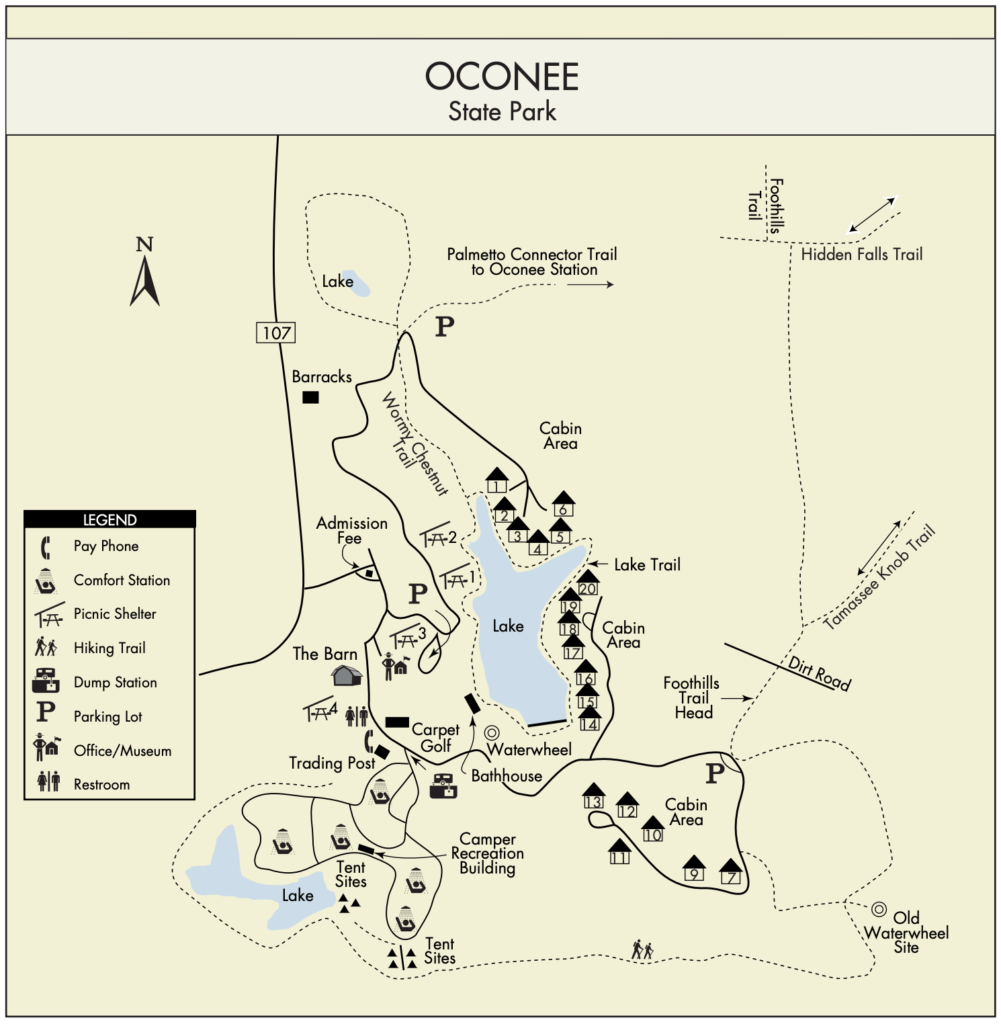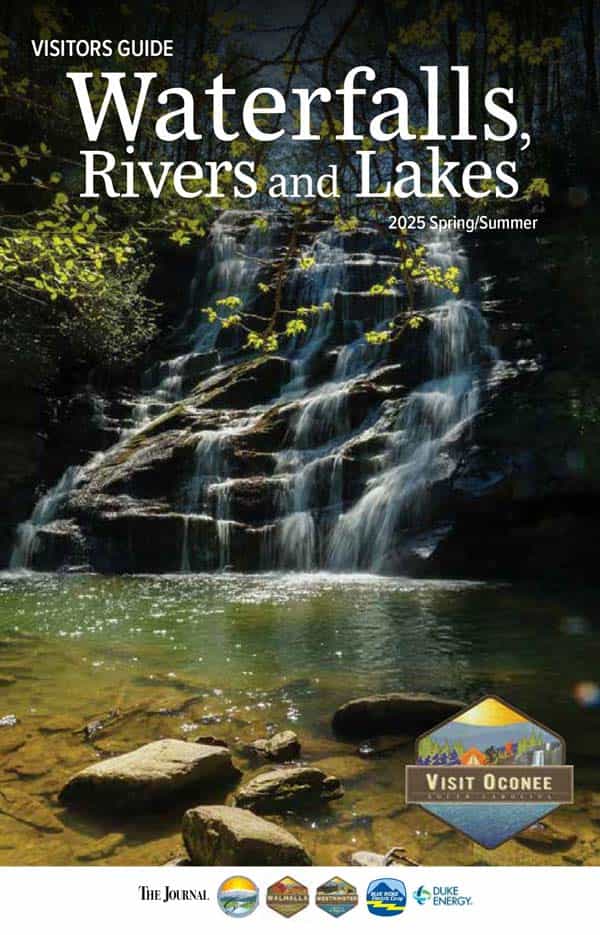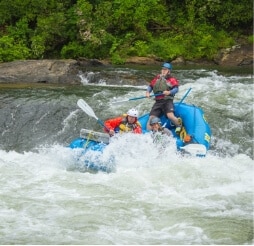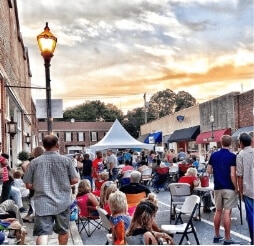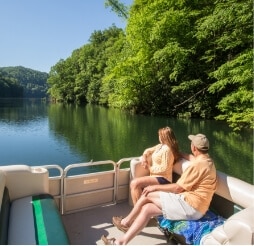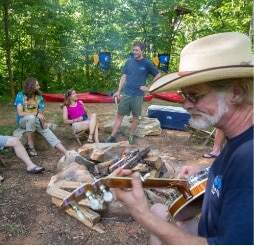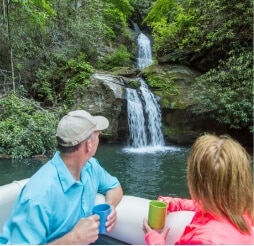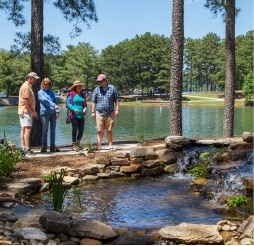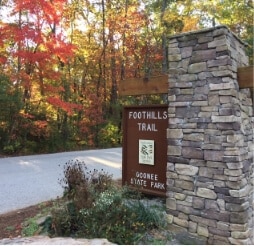Oconee State Park sits on 1,165 acres at the foot of the Blue Ridge Mountains
Historic Beginnings
Oconee State Park opened to the public in 1937. It was one of 16 parks in South Carolina built by the Civilian Conservation Corps–and the only one they built in Oconee County.
Civilian Conservation Corps
The Civilian Conservation Corps (CCC) was part of the federal New Deal program initiated by President Franklin D. Roosevelt to put men to work to alleviate the ravages of the Great Depression. The CCC began in 1933 when President Roosevelt signed the Federal Unemployment Relief Act. This act recruited unemployed, unmarried men to join the CCC. They lived in segregated camps that operated under military-style rules. They received shelter, clothing, and food. The men were paid $30 a month, and $25 was sent directly home to their families.
CCC enrollees in state park projects worked on almost every aspect of park development, including clearing campsites, building cabins, bathhouses, and residences, landscaping camp areas, constructing roads, bridges, and firebreaks, and building picnic shelters, barbecues, benches, entrance signs, hiking trails, and recreational areas.
Wow, those CCC boys got things done!
- The CCC boys were also known as “Roosevelt’s Tree Army.”
- Nearly 3 million men were put to work doing reforestation, construction of fire observation towers, laying telephone lines, and developing parks.
- Workers lived in 2,600 camps across the United States.
- During the years of the CCC program, over 1,000 national, state, county, and city parks were built.
- 800 state parks were developed.
- CCC work was done under the direction of the U.S. Forest Service, National Park Service, Soil Conservation Service, U.S. Fish and Wildlife Service, Bureau of Land Management, and the Bureau of Reclamation.
- 85,000 Native Americans enlisted in the program.
- 63,256 buildings were constructed along with 8,045 wells and pump houses.
- 45 million trees and shrubs were planted.
- 46,854 bridges were built.
- 3,462 beaches were improved.
- 7,622 dams were built.
- The CCC developed 6,966 miles of wildlife streams.
- One billion fish were stocked.
- 28,087 miles of foot and horse trails were laid, and 8,304 foot and horse bridges were built.
- They built 32,149 wildlife shelters and 1,865 drinking fountains.
- 3,980 historic structures were restored.
- 204 lodges and museums were established.
- 405,037 signs, markers, and monuments were erected and 3,116 lookout towers.
- The CCC was phased out in 1942 when many of the enrolled men enlisted to fight in World War II.
CCC Evidence at Oconee State Park
The park office has authentic CCC artifacts on display in the retail store.
The actual waterwheel remains, but the structure itself is a replica of the original. The waterwheel was essential during park construction. It was used to generate power for the workers and supplied their drinking water.
Original stacked stone rock work along the Old Waterwheel Trail has stood the test of time, as have 19 cabins, the barn, bathhouse, picnic shelters, and park offices. Yellow emblems on buildings signify that they were built by the Civilian Conservation Corps.
It is interesting that much of the rock used in these structures came from Stumphouse Tunnel and wood came from American Chestnut trees. (Not long afterward, this tree species died out in the Southern U.S.)
A bronze statue was erected in front of the park offices in 2001 to honor the memory of over 3 million members who served in the Civilian Conservation Corps.
Modern Day Getaway
Oconee State Park is a great place to disconnect from the world and reconnect with nature! As the name implies, the setting in Mountain Rest, SC is lush forest and a rural surroundings. This means no internet, no Wi-Fi and no TV. It actually is possible to get internet at the park office, but WiFi is not available in the cabins, campground, RV sites or anywhere else in the park.
What you will have is wilderness with a small lake stocked with trout. A putt golf course. Easy to moderate hiking trails in the Sumpter National Forest with panoramic mountain views. Multiple waterfalls just a short drive away and an easy hike to Pig Pen and Lick Log Falls that ends with a great picnic area and swimming hole at the Chattooga River. End the day with a fire, wine, and dinner cooked outdoors. Enjoy the star lit sky. Go to sleep, wake up and do it all over again!
Park Admission: $5/adult; $3.25/SC seniors; $3/child ages 6-15; ages 5 & under free
The park offers low-key recreation including
- camping
- fishing
- boating on two small lakes
- hiking on eight nature trails
- picnic shelters
- playgrounds
- a mini-golf course
You can rent paddle boats, canoes, and kayaks to paddle around the lake. Friday night square dances are held in the barn at the park from Memorial Day to Labor Day.
The southern trailhead for the Foothills Trail and the Oconee Passage of the Palmetto Trail are both accessible within the park.
Oconee State Park has 139 standard campsites with water and electricity. There are 15 rustic tent sites and 19 historic CCC cabins (many of which are on the lake).
For more information about park offerings, or to book lodging, go to https://southcarolinaparks.com/oconee.
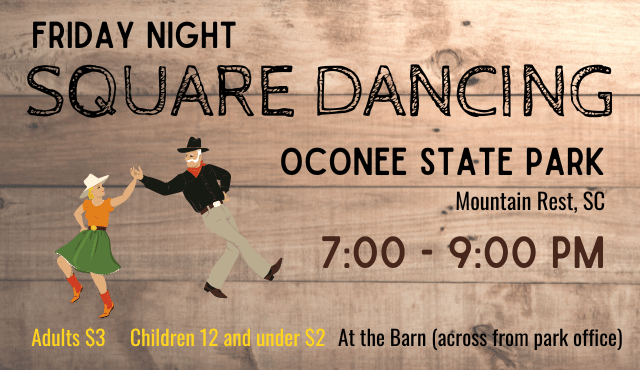
Who They Were
The following was written in the 1990s by an anonymous Civilian Conservation Corps Alumnus:
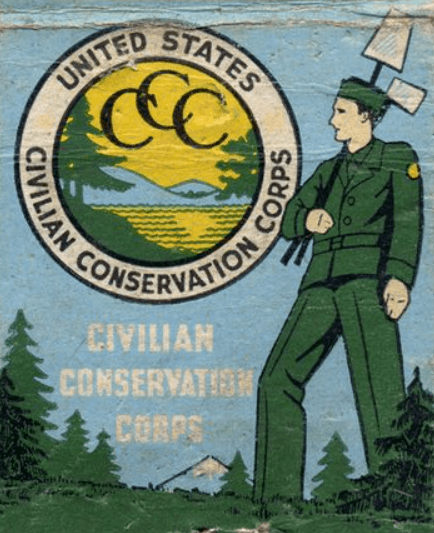
“We are the young men of the 1930s who made up the Civilian Conservation Corps between 1933-1942.
We are the young men who mended the scarred land and fields, the muddied waters of our creeks and rivers, and the depleted woodlands of our country.
We replanted our forests from Maine to California. We built the fire trails to protect the old and new forests; cleaned out the diseased deadwood to protect the healthy and new trees; and fought forest fires and floods.
We built lodges and campsites in our national parks so that people could enjoy our beautiful country. We built the roads and trails in the parks–many of which are still in existence today.
We worked in the quarries to produce the building stone needed to build the dams in our state and national parks–the same dams that stand today creating lakes that have given recreation to campers, fishermen, and family groups for over the last 60 years.
We worked in quarries getting the rock to crush for limestone to spread on the farmlands to sweeten the overworked soil, which helped restore productivity. From other quarries came the building stone needed for masonry dams and flumes, which controlled the rapidly eroding soil.
We were educated and given job opportunities, honor, respect, and a purpose in life.
All over this country, the work we did with our hands, our minds, and our bodies still stand today as a monument to the youth of the 1930s and what we accomplished, bearing in mind that 90% of what we did was done by hand, pick, hoe, ax, shovel, mauls, drills, and wheelbarrows.
We put our mark on this land, and that mark will be seen for many more years to come.
As a generation, we have much to be proud of. We have earned a place in history, and speaking, as an individual, I am grateful for having had the chance to be there.”
What They Did For A Dollar A Day
Written by John B. Derden, CCC Enrolee 1937-1939:
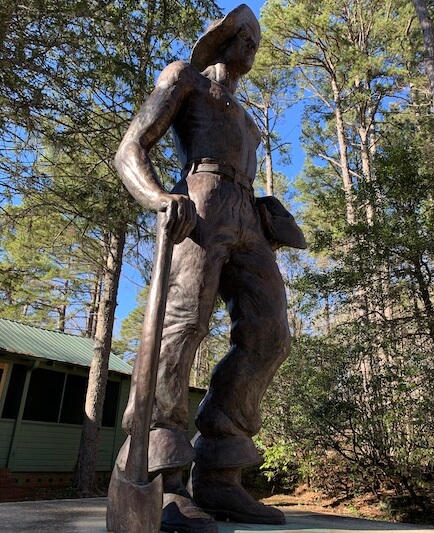
“In the depth of the Great Depression in 1933,
President Roosevelt created the CCC.
For our nation he had a plan—
To give young men jobs, improve our forests, and build state and federal parks throughout the land.
From the country, villages, towns, large cities, and the ghettos, by the thousands we came.
We were eager to participate in FDR’s CCC game.
Our uniforms and equipment were 1917 army style.
And every time we went to town, the girls would point to our pistol-legged trousers and smile.
We lived in tents and barracks and had to sweep the floors and make up our bed.
We shined our shoes, brushed our teeth, and combed our head.
To heat the barracks we built our own fires and cut our own wood.
The need for dry kindling was well understood.
They taught us to lay rock, pour cement, and build lakes for wild geese and ducks,
to operate bulldozers and drive trucks.
We dug ditches, built roads, and sloped banks,
built campgrounds, log cabins, and water tanks.
We worked in the rain, the snow, and the mud,
to crush rock, cut logs, and rescue people from the Mississippi flood.
Our camps were located all across the land
from Alaska to Death Valley’s burning sand.
We were often stationed far from home in places we had never been
to perform hard work with very little money to spend.
When in town, if we asked girls for a date they would say, “No thanks, we go out with railroad men.
Because you CCC boys only have five dollars all month to spend.”
With axes, rakes, saws, and leaking fire pumps on our back,
we climbed mountains to fight fire all day with only a sandwich in a paper sack.
If we ever went home for a visit, we always had a short time to stay,
because we had to hitchhike or walk all the way.
Working in the kitchen would have been a good deal,
but they had too many pots and pans to wash and too many spuds to peel.
In the evening before we could eat,
we lowered the flag and had retreat.
We did our work well all across the land; our forest roads are still lined with
our shrubs and trees.
And as people ride by and enjoy the scenery, they always say, “These roads and
trees were put here by the CCC’s.”
And we are proud to say,
We did this all for just a dollar a day.”
- Tags: Discover Oconee, Heritage, Parks, Recreation
-
Post Author: Ken Sloan

